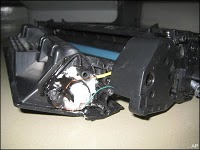By: Trevor Loudon
New Zeal

Spencer Ackerman at Wired News examines the recent cargo plane bombing attempt – alleged to have been organized by Al Qaeda. Experts are still unsure as to the purpose of the cellphone motherboard which was attached to the bomb. Had the terrorists set an alarm on the phone which would trigger the device, or were they intending to call or message the phone, initiating detonation?
“They couldn’t call,” says Roger Cressey, a former counterterrorism official in the Clinton and George W. Bush administrations. If the terrorists used a regular cellphone to call an airplane-borne bomb from a great distance, it probably wouldn’t be able to reach a tower that could bounce a signal to the phone — though it’s not impossible.
“It’s pretty damn hard” to succeed at a mail-borne intercontinental bombing, says a former intelligence official who requested anonymity because he’s still a government employee: “You stick it in the mail, it goes on a plane, the plane’s gonna fly, but you better hope it goes off.” …If al-Qaeda is the culprit, the Pentagon adviser says, the terror group is showing “declining capability.” Hijacking multiple aircraft on 9/11 is much more complex than trying — unsuccessfully — to blow up a pair of passenger or cargo planes.
Here’s a comment from Scott Stewart at the Stratfor website:
The Oct. 29 discovery of improvised explosive devices (IEDs) inside two packages shipped from Yemen launched a widespread search for other devices, and more than two dozen suspect packages have been tracked down so far. Some have been trailed in dramatic fashion, as when two U.S. F-15 fighter aircraft escorted an Emirates Air passenger jet Oct. 29 as it approached and landed at John F. Kennedy International Airport in New York. To date, however, no other parcels have been found to contain explosive devices.
The two parcels that did contain IEDs were found in East Midlands, England, and Dubai, United Arab Emirates, and both appear to have been sent by al Qaeda in the Arabian Peninsula (AQAP), al Qaeda’s jihadist franchise in Yemen. As we’ve long discussed, AQAP has demonstrated a degree of creativity in planning its attacks and an intent to attack the United States. It has also demonstrated the intent to attack aircraft, as evidenced by the failed Christmas Day bombing in 2009 involving Umar Farouk Abdulmutallab, who tried to detonate an explosive device concealed in his underwear on a flight from Amsterdam to Detroit.
A tactical analysis of the latest attempt suggests that the operation was not quite as creative as past attempts, though it did come very close to achieving its primary objective, which in this case (apparently) was to destroy aircraft. It does not appear that the devices ultimately were intended to be part of an attack against the Jewish institutions in the United States to which the parcels were addressed. Although the operation failed in its primary mission (taking down aircraft) it was successful in its secondary mission, which was to generate worldwide media coverage and sow fear and disruption in the West.
Scott continues, going into detail of the tactical details of this failed terrorist attempt, and the apparent fixation jihadist groups have for attacking aviation targets. Click here to continue reading.



![Ted Cruz: This Is Why The Left Is Utterly Terrified Of Jeff Sessions [VIDEO]](https://noisyroom.net/blog/wp-content/uploads/2017/01/Jeff-e1484087650235.jpg)














